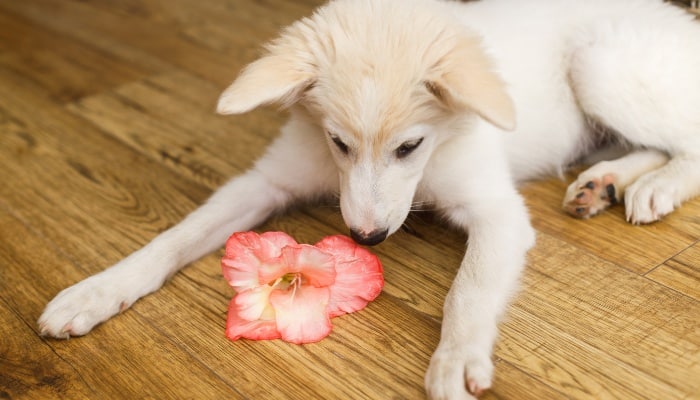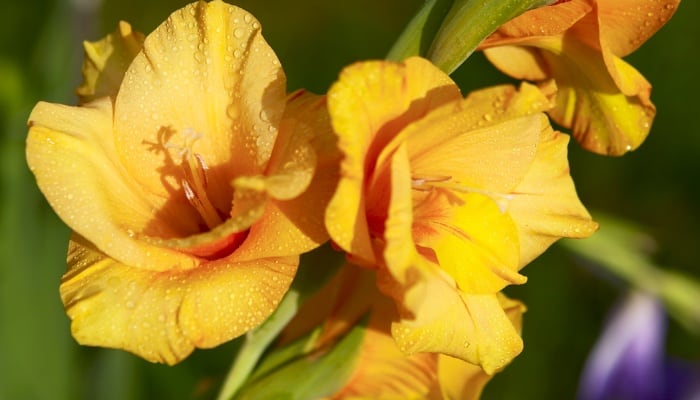Often, when planning a garden, one may not consider the harmful effects of certain plants. It is important to note that some seemingly beautiful flowers can actually be toxic.
It may be best to avoid planting gladiolus varieties if you have overly curious house pets or young kids.
Are gladiolus poisonous to dogs? The bulb, bud, and leaves of gladiolus are poisonous to dogs. If any part of the plant is ingested, it will cause vomiting, salivation, drooling, diarrhea, and lethargic habits. Be sure not to allow your dog to dig up the bulbs and consume them because this is the most toxic portion.
To understand if you can have both gladioli growing as well as peace of mind when it comes to your dog’s health, continue reading to better understand what parts of gladiolus plants are poisonous.
This article also outlines gladiolus poisoning symptoms, how to diagnose poisoning, and how to treat it.
Are Gladiolus Poisonous? What To Know
Members of the Iridaceae family, the perennial gladiolus is toxic to dogs, cats, and humans if consumed. Toxicity is mostly associated with high levels of alkaloids that are found in ornamental bulbs.
If your dog likes to dig, gladiolus may not be a good option to plant in your yard. Read on to find out more!
What Parts of Gladiolus Are Poisonous?
The highest concentration of toxins is located in the bulbs and buds; however, the entire plant contains toxins.
Once ingested, any part of the plant will cause gastrointestinal issues, and if ingested in high-enough quantities, long-term liver or kidney issues may arise.
Are Gladiolus Poisonous To Touch?
While they contain toxins throughout, simply touching the plant should not cause any harm. Wear gloves when harvesting flowers because the sap may cause skin irritation.
Feel free to harvest blooms, and use them in arrangements since it is only toxic if ingested.
Are Gladiolus Poisonous to Cats?
Just as the plant is toxic to dogs, it is also toxic to cats. While cats do not dig like dogs, they may try to eat the flowers or leaves that also contain toxic levels of the poison.
Can Gladiolus Kill Dogs?
In most cases, consuming just a small amount will only cause temporary symptoms.
However, if large amounts are eaten or the dog continues to eat part of the plant over time, cardiac issues may arise as well as kidney and liver health issues.
Are Gladiolus Poisonous to Humans?
Gladiolus are poisonous to humans as well! Enjoy their blooms, but be sure to never eat any part of the plant.
Symptoms of Gladiolus Poisoning
Most symptoms of gladiolus poisoning include gastrointestinal issues. If ingested, it will cause vomiting, salivation, drooling, diarrhea, and lethargic habits.
While these should wear off over time, symptoms that seem more serious should be looked at by a vet for proper diagnosis and treatment.
Diagnosis of Gladiolus Poisoning
To confirm gladiolus poisoning, check where you have gladiolus growing and investigate to see if any part looks like it has been dug up or eaten.
Your dog may have been digging for something else and ended up eating the bulbs by accident.
If you notice bulbs or plant pieces in your dog’s vomit, he or she most likely ate some part of the gladiolus plant.

Treatment for Gladiolus Poisoning
Treatment will most likely include induced vomiting followed by more invasive techniques to remove the poison if necessary.
Take your dog to a vet quickly if serious poisoning is suspected. They may give your dog a charcoal lavage to absorb any other toxin and start an IV therapy if your dog has had diarrhea.
What To Do if You Suspect Your Pet Ate Gladiolus
If you suspect your pet has eaten gladiolus, it is best to take your pet to the vet immediately. Besides induced vomiting, there isn’t much you can do to treat the symptoms or diagnose how serious the poisoning is without a professional’s advice.
Other Common Garden Plants That Are Poisonous
While beautiful, many flowers are also poisonous. Varieties of daffodils, snowdrops, hyacinths, irises, amaryllis, and tulips are all varieties of poisonous plants.
Other poisonous varieties include lantanas, lily of the valley, foxglove, wisteria, hydrangea, azaleas, and other lilies.
For an extensive list of plants that are toxic to cats, dogs, and other animals, check out the ASPCA’s official list.
How To Enjoy Gladiolus AND Keep Your Pets Safe
Sometimes you just have to be careful where you plant gladiolus to ensure you can enjoy its blooms and have piece of mind when it comes to your pets.
Planting gladiolus in a planter well away from your pet’s reach will help to keep cats and dogs from becoming curious and prevent them from eating any of it.
Do not leave bulbs around in any areas your pets have access to as they can quickly become chew toys.
Gladiolus Growing Tips
- Chose the right corms when planting. The larger the corm, the larger the plant and blooms will be, and the smaller the corm, the smaller the overall plant will grow.
- Plant them in any type of soil; they only dislike clay soil types.
- Plant the largest corms about 4 to 6 inches deep, medium-sized corms 3 to 4 inches deep, and small corms 2 to 3 inches deep.
- Plant each corm about 5 inches apart to allow for ample growing space.
- Plant them in the spring.
- Plant them in succession every 2 weeks to guarantee blooms all season long. The last succession can be planted no later than July to allow for ample time for the corms to mature and bloom.
- Plant them in full sun for at least 6 to 8 hours a day of direct sun exposure.
Related Questions:
Are Crocuses Poisonous to Dogs?
Crocuses are part of the Iridaceae family and are poisonous to dogs. Spring crocus will cause gastrointestinal issues like vomiting, diarrhea, and drooling if consumed.
The fall crocus is more toxic and may cause excessive gastrointestinal issues including vomiting, diarrhea, and kidney, liver, and bone marrow damage.
Are Tulips Poisonous to Dogs?
Tulips are poisonous to dogs. All parts are poisonous if ingested, so they should be avoided if you have dogs that will eat most things. Symptoms may include vomiting, drooling, and diarrhea if ingested.
Conclusion
The most beautiful varieties seem to also be the most poisonous. It’s always better to be safe than sorry when it comes to pets, so avoid planting gladiolus or most other bulb flowers if you have curious pets!

